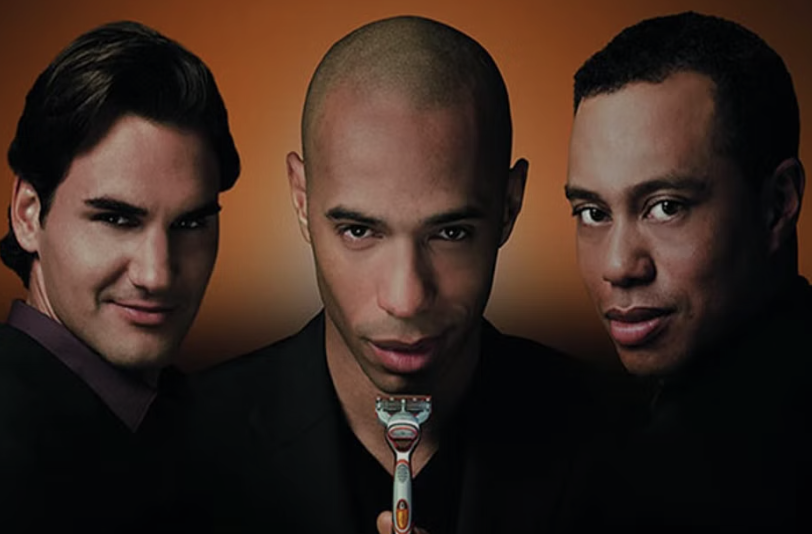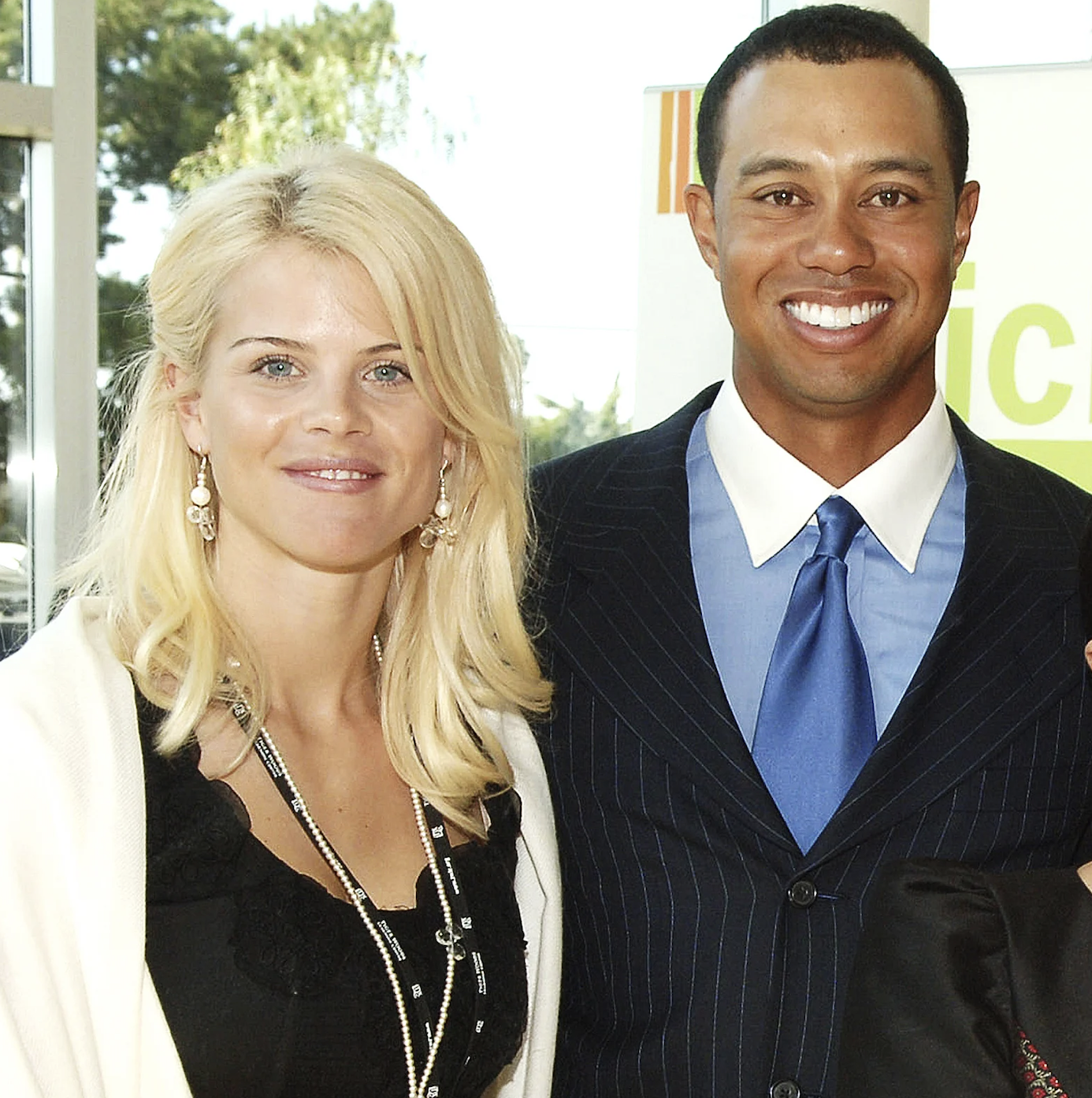Tigermania
Tigermania was a cultural phenomenon that evoked conversations about how black celebrity athletes are produced and exhibited in the mainstream media (which contains a white bias). At the young age of 21, Tiger shot up to national superstardom and at some point wherever he went in public, herds of screaming fans and paparazzi would follow. Tigermania is also an interesting case study on the ways in which race affects perception within scandal and celebrity culture in America. Woods strictly controlled what people said about him and his brand by attempting to separate most details about his private life away from the game. Americans knew virtually nothing about Tiger's personal details which added to his mysticism and caused people to put him on a pedestal to worship.
Tiger's Brands

TAGHuer
Through his sponsorship with watch retailer TAGHeuer, Tiger exudes luxury and prestige in his image while staying consistent to golf's ideals of wealth and consumerism.

Gatorade
Gatorade's symbolization as the ultimate fuel for winners, toughness, and sweat depicts Tiger as a hardworking athlete, and on a deeper level, challenges traditional "laziness" stereotypes of black athletes.

Buick
Since cars often are associated with masculinity and the American dream, Tiger own pristine image complements his brand deal with Buick and caters to national core values of freedom, independence, and success.

Gillette
Similarly to Buick, Gillette ads accentuates the perception of Tiger's masculinity and further emphasizes male attractiveness to convince white consumers that his appearance is appropriate enough to look at and admire.
Tiger Woods with his wife Elin, daughter, Sam, and son, Charlie, in February, 2009.
Dom Furore/Woods Family
Family Man
In regards to his personal life, Tiger carefully crafts a clean image to present
himself as a family man with a picture-perfect family that exemplifies the idyllic
appeal of the American nuclear family.
Successful, rich, and surrounded by familial love, the Woods family photo seems
to provide proof that the American Dream is attainable for non-white people, that
if you worked hard to achieve success, anyone can have what Tiger has, and how racial
progress has already been advanced to the point where if racial communities are struggling,
it's because they don't try to model themselves after Woods's behavior and status.
Nevermind that exceptionalism has always been a key aspect of Tiger's rise to the top of
the golf world and as one of the world's highly-esteemed celebrities to climb to fame. At
the time of the photo, Tiger Woods's image was untouchable.
Woods and Obama draw comparisons with their similar backgrounds and their perseverance in rising to the top of once whites-only professions and becoming cultural icons.8 Both men's mixed race backgrounds were subjected to much discussion over their place in traditionally white-dominated spheres and used as indicators of America's racial progress.

Illustrated imagining of Woods and Obama on the course together on the cover of Golf Digest, 2010.
Golf Digest
Some people even argued that "Woods helped to pave the way for Obama's election by getting more white Americans accustomed to a high-achieving and seemingly trustworthy black man."8 Woods is seen as a trailblazer for non-white men to achieve in white dominated spaces, helping to enforce an illusion of racial progress in America.
The cover story on a US Weekly magazine alleging that a Los Angeles cocktail waitress had a 31-month affair with Tiger Woods.
Associated Press
A Spectacular Fall from Grace: Tigergate
In November 2009, the National Enquirer published the first story claiming that Woods had an extramarital affair but it wasn't picked up by the mainstream media. That same month on Thanksgiving, Woods crashed his SUV in his Florida neighborhood around 2:30 a.m., allegedly fleeing his mansion after his wife discovered Tiger's affair. The intense media coverage and speculation surrounding the incident heightened Tiger's visibility in the media, so when US Weekly magazine released a second story alleging Tiger's infidelity, the story blew up, eventually exposing all of the other affairs Tiger had with multiple women and sensationalizing the event as "Tigergate".
Three key factors played substantial roles in generating the hysteria over Woods' extramarital affairs:
First is that the scandalous nature of the event completely goes against golf's reputation as a sport that values honor, good sportsmanship, and gentlemanly etiquette. With the game so centered around enforcing a strict code of ethics and morals, a golfer causing a scandal of this magnitude for seemingly discarding personal morals valued by the American public, such as faithfulness and honesty, was extremely shocking and yet especially juicy gossip to feed to America's celebrity culture.
The second is that the acts weren't committed by just any golfer–it was Tiger Woods, a perceived family man with a clean image and champion of America's values. He was viewed as someone who was untouchable from drama or dirt thrown his way, with a life that seemed so idyllic and was the American familial standard.
Thirdly, the scandal occurred at the peak of the internet, emboldening Americans to take advantage of the anonymity to insert their true opinions on the matter in regards to how it touches upon sensitive topics such as race, sex, and misogyny. When investigating the online response to Tigergate, Orin Starn claims to find that "all manner of prejudice, bigotry, and sometimes sheer weirdness gushed to the surface."8
Tigergate exposed the ways in which racial connotations are played out in America's mainstream media and how Tiger's racial identity can be just as easily manipulated to aid in Tiger's downfall to villainize him as it is to portray him as a savior to America's racial issues and utilize his image to protect white American ideals. Similarly to the conclusion in the Billings study2 (sports broadcasters use white stereotypes to portray Tiger when he is playing well versus using black stereotypes to negatively portray Tiger when he is failing), when he is popular among the public, America identifies Tiger with white ideals connected to moral superiority. But with public opinion very low of him during Tigergate, America views Tiger through the traditional narratives of black moral transgression.
Blurring the Lines Between Reality...and Reality TV
The tabloid business is a multibillion dollar industry
that purposefully sensationalizes scandals like Tigergate
to stir up intense emotions from the public, from
excitement to outrage, and often their relentless
coverage during scandals feed off from damaging the
reputations of its subject.
The media frequently distorts the perception of events
to sensationalize them beyond proportion. With each mistress
of coming forward, each racy detail revealing itself, each
paparazzi picture of Tiger's estranged wife Elin being
released, the media inserts itself into Tiger's private
exploits to publicly judge him with no obligations to
respect the boundaries of his personal life. However
the media's own relentlessness can backfire, driving
people to scorn it as cheap entertainment that
hyperbolizes meaningless subjects.
The sensationalized coverage of Tigergate became like
a reality TV show itself–a spectacle that encourages
large-scale discussions, jokes, and individual opinions
and opens the door for perpetuation prominent racial
stereotypes. Reality TV may happen in real time, but
it often fabricates its narratives to push storylines
more interesting to viewers, which is something that
the tabloids do to draw more attention. What happens
if the media chooses to push a problematic narrative
about Tiger's personal failings based on traditional
black stereotypes that appeal to white America?
Scandal in Pop Culture
Starn makes a noteworthy point about how scandal could
be seen as a democratic leveler, "cruel for celebrities
and comforting for us". Scandal allows fans to obtain
a sense of moral righteousness in their ability to put
celebrities at their mercy of their "judgement",
"Internet polls", or "forgiveness."
With the popularization of social media and the press,
there is a level of intimacy Americans feel with the
celebrities they connect with, also known as para-social
relationships. In Tiger's case, many fans felt a deep
sense of betrayal and enrage in reaction to Tiger's
misdeeds. This raises the question of whether Tiger's
fans deserved to be given answers from Tiger and if
Woods had any obligation to be held accountable by
his fans. "The line between audience and celebrity
has become more porous, in an age where we know so
much more about the private lives of the rich and
famous," writer Maggie Quale explains.
His actions shattered the expectations put on him to
represent the best qualities of golf, with many former fans
drawing from racially-connoted descriptors to describe how
they viewed him, such as "arrogant, spoiled, bad tempered,
childish, immature, foul-mouth, whiny, disloyal,
condescending, infantile, repugnant, etc." The quick
reversion back to the use of stereotypical black
descriptors and how it completely disregards the
clean, respectful image of Tiger pre-scandal. While
in the past, racism was explicit and legal, today
there is a "racial paranoia" that characterized by
"extremist thinking" and "general social distrust"
especially towards African-Americans. During
Tigergate, the media constantly attacks Tiger's
disloyalty, painting a picture of him that
aligns with the notion of "distrustful"
African-Americans and holds no excuses
for Tiger's behavior.
Fun fact: The Tiger Woods story graced the cover of the New York Post for twenty consecutive days, one more than the old record held by 9/11.
Revisiting Tiger's Racial Identity

Tiger Woods and Elin Nordegren.
L. Cohen/WireImage for PGA TOUR
The discussions around Tigergate revisited
the debate about whether or not Tiger rejects
his blackness through his interracial
relationships with white women.
Woods received some disapproval from
black women who were "upset he had
chose to marry a white woman"8 ,
but the reveal of all of his mistresses
(and the fact that they're all white)
spurred online accusations that Tiger
was not "black enough" and that he was
a "race traitor."8
While reporting from the media and tabloids contained
underlying racial biases, the internet gave people an
anonymous platform to say any sort of racist or
misogynistic comment about Tigergate and express
disgust over Tiger's failings in his representation
of the black community.
On the flip side, while many black people felt
that Tiger rejected his blackness, Tigergate
also opened the door for the hyper sexualization
of Tiger as a black man, attributing his scandalous
behavior to stereotypes of "violence", "athletic
prowess", "aggression", and "sexual predation"
that commonly describe hypersexualized black
masculinity.8
Some people on the internet celebrated Tiger as a macho
"player" with his "gansta sexual prowess."8 The 2010 Tiger
Woods Vanity Fair cover draws from these cliche notions of
the black gangster, highlighting Tiger's masculinity and
his black form of masculinity. This is far different from
Tiger's origins as a golf nerd from suburban Southern
California.
Additionally, conversations about protecting American ideals
arose with a number of white men who feel that white masculine
privilege was being threatened by the growing awareness of racial
injustice and inequality. The mythologized American family and the
sacrality of marriage were doubled down upon when it came to criticizing
Tiger Woods and proving that he (along with most black men) doesn't
fulfill what it means to be the typical American male hero archetype
because he is perceived as a hypersexual black man.
The sexualization of Tiger operates on black tropes of deviancy and
savagery, which are seen as threats to the American way of life and white
Christian beliefs that invoke purity and monogamy.

2010 Vanity Fair Cover of Tiger Woods.
Annie Leibovitz/Vanity Fair
The "One-Drop" Rule
*The 10:08–11:07 section of the video shows Tiger mentioning his Asian identity, bringing forth his multiracial identity to remind the public of the contributions Tiger made to help America achieve its post-racial fantasies. Is it also an subconscious attempt to separate himself from the stereotypical image of black moral deviancy?
The road to redemption for black men is often
met much resistance because many believe they
are unable to be redeemed because notions of
deviancy are ascribed into the perceived nature
of black men. Conversely, people are more easily
forgive white men because they are humanized
and their transgressions are seen as mere obstacles
to their character-building. Thus, black men
are viewed as inherently bad and white men
are seen as inherently good. How Tiger's
multiracialism is twisted by the public adds
an interesting dynamic to people's judgement
on his apology and chance of redemption.
Tiger's apology for the scandal was carefully formulated
to rehabilitate his image but was also viewed as genuine,
taking full responsibility for his actions, condemning his
behavior, and acknowledging the people he hurt. Unlike
the confident persona people are used to seeing from
Tiger on the golf course and through his branding, he
looks contrite, remorseful, and vulnerable.
Many people believed that he truly wanted to repent for
his actions, and even further, believed that he had a right
to take care of his persona business privately with his wife
and family and that he didn't owe the public an apology. A
columnist from the Washington Post commended Tiger's apology
as "revealing the 'real' Tiger", showing the real man
underneath his corporate, money-making image.8 Tiger's
previous clean image that adopted white ideals of the
family likely helped garnering less harsh judgement of
his character than the typical black athlete. Along with
the news that he had entered into rehab for his sex
addiction, Woods's methods of apologizing and making
amends for his behavior is on par with the methods
emphasized on by the media that most white athletes
use to rehabilitate their images.7
However, for his redemption, Tiger was not viewed as multiracial
and instead was portrayed as a black man. Forcing an erasure of his
multiracialism in regards to the scandal enacts the "one-drop" rule
used to question any kind of blackness. The one-drop rule decrees
that if a person has any kind of black ancestry, even "one-drop
of black blood", they are considered and should be perceived as black.8
Therefore, Tiger faced harsher scrutiny than that of controversial white
athletes because of a general eagerness to vilify Woods, stemming from
the public's longing to find fault with his blackness and divert the
perception of his failings away from being associated with the white
ideals of his branding.
This concept of the "one-drop rule" is exemplified in Augusta National's treatment of Tiger a year after the scandal. In a press conference at the 2010 Masters, the day before Woods's return to golf, the chairman of the Augusta National Club Billy Payne decried Tiger for damaging the reputation of golf and going against its ideals:
"Our hero disappointed all of us [with his] egregious off-course behavior and [failed] to live up to his expectations as a role model that we sought for our children. We at August hope and pray that our great champion will begin his new life here tomorrow in a positive and constructive manner...his future will never again be measured only by his performance against par, but by the sincerity of his efforts to change." 8
Despite its prestige as the host of the Masters tournament, Augusta National was a proud emblem of white elitism and racial discrimination, and the club did not admit a black member until 1990. Moreover, women were not allowed membership at the club until 2012, even further indication of Augusta National's conservative roots. Payne's comments about Tiger were criticized for its racial undertones, with critics arguing that Payne wouldn't have publicly disparaged Tiger if he were white. Even though Tiger was one of the most decorated golfers in history, Payne still made a point to distinguish Tiger from golf's white values, racially-othering Woods in order to preserve the moral and elitist righteousness of golf.
How did Tiger's Fall From Megastardom Affect How People Reconciled with his Race?
Tigergate showed a vulnerable side of Tiger Woods that
had never been seen by the public. The lure of his
brand rests on Tiger's mystique–he gave white America
what it wanted to see without giving up exquisite
details about his personal life, tightly controlling
the spread of information regarding his family and
private endeavors. Now that Tigergate aired all of
Woods's secrets, the mystery and speculation on the
"true" Tiger Woods disappeared as people moved on
to the next big headline.
Scandal has the ability to take celebrities off of a
pedestal until they do not seem so different from everyone
else, a process both humanizing and demeaning all at once.
In the case of Woods, Tigergate caused many people to reexamine
how they blindly idolized him as a champion of America's
colorblindness and provoke them to reduce Tiger to stereotypical
views of blackness. His clean image destroyed, Tigergate
exposed that Tiger was just as vulnerable to crude and
terrible racial discourse as other black athletes who
were not as powerful as him and the general population
of black men that encounter a more normalized version
of this racism.
Tiger's multiracialism gave people the option to pick and choose
which parts of his identity suited their narratives best, and they
were given an excuse to put all of the blame on his blackness when
his indiscretions came out. What is not taken into account is a
prominent theme in American culture of powerful men regardless of
any race abusing their status and believing that they could do and
get away anything without being held accountable. White men who
are notable examples include President Bill Clinton and former
Republican Governor of South Carolina Mark Sanford. Tiger's
infidelity is not entirely different from this narrative,
but he is viewed as even more morally reprehensible than
other men who engage in extramarital affairs because of
the racially-biased narrative of hypersexual black masculinity.
Images and Media
Header Image
Associated Press/Getty Images, "Dec. 4-11", 2009, https://www.golfchannel.com/media/tiger-woods-scandal-10-year-anniversary-car-crash?slide=5. Accessed 7 Dec. 2022.
Background Images
Cannon, David/ALLSPORT. "US Open", 1997, https://golf.com/gear/golf-accessories/vintage-tiger-pictures-you-can-buy/. Accessed 2 Dec. 2022.
Media
Associated Press, "Tiger Woods offered a 'profound apology' to his supporters Wednesday after US Weekly magazine published a cover story alleging that a Los Angeles cocktail waitress had a 31-month affair with the world's No. 1 golfer'", 2009, https://www.sandiegouniontribune.com/sdut-players-tee-tigers-tourney-2009dec03-story.html. Accessed 12 Dec. 2022.
Buick. SM Consulting. 2008.
Cohen, L. WireImage,Tiger Woods and Elin Nordegen, https://www.usmagazine.com/celebrity-news/pictures/tiger-woods-elin-nordegrens-quotes-about-their-relationship/. Accessed 12 Dec. 2022.
ESPN, "Augusta National", 2019, https://espnpressroom.com/caribbean/press-releases/2019/04/espn-and-augusta-national-golf-club-to-present-the-masters-tournament-in-latin-america-and-the-caribbean/. Accessed 12 Dec. 2022.
Furore, Dom/Woods Family, "Tiger Woods with his wife, Elin, daughter Sam, and son, Charlie, in February. 'Having the two kids is just unbelievable,' he said." February 2009, https://www.nytimes.com/2009/06/14/sports/golf/14woods.html. Accessed 12 Dec. 2022.
Gatorade. TechInAsia. 2009.
Gillette. Independent. 2009.
Golf Digest, Barack Obama and Tiger Woods, 2010, https://www.golfdigest.com/story/barack-obama-and-tiger-woods-play-first-round-of-golf-togeth. Accessed 12 Dec. 2022.
Leibovitz, Annie. Vanity Fair. 2010 Tiger Woods Vanity Fair Cover, 2010, https://www.vanityfair.com/culture/2010/02/tiger-woods-201002. Accessed 12 Dec. 2022.
Neil Best. Newsday, "Tiger Woods, Bigger than 9/11", 2009, https://joshmadison.com/2009/12/18/tiger-woods-bigger-than-911/. Accessed 12 Dec. 2022.
New York Post Sports. "Tiger Woods' Full Apology Speech | New York Post Sports", Youtube, uploaded by nypostsports, 19 Feb. 2010, https://www.youtube.com/watch?v=w0m87G2FzWA
sportssox10. "Hilarious video Jimmy Kimmel 'Tiger Woods'", Youtube, uploaded by sportssox10, 4 Jan. 2010, https://www.youtube.com/watch?v=_llZ7Gset9E
TAGHuer. Huffington Post. 2011.